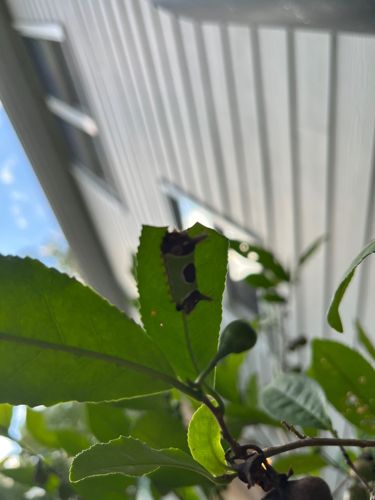Caterpillar (likely a Geometrid moth larva, also known as an inchworm or looper, based on its posture and the type of damage)
Scientific Name: Too difficult to identify definitively from the image, as many caterpillar species look similar and require detailed examination. For Geometridae, examples include species within genus Alsophila, Operophtera, etc., but this is speculative.
Order & Family: Order: Lepidoptera (butterflies and moths); Family: Geometridae (if it is an inchworm/looper, due to its characteristic looping movement, although this is not evident in the still image, the body shape is suggestive). Without clearer identifying marks, a more specific family is difficult to ascertain.
Size: Caterpillar sizes vary widely depending on the species and instar (developmental stage). A typical size for the visible portion of such a caterpillar could be around 1-3 cm (0.4-1.2 inches) in length, but some species can grow much larger (up to 10 cm or more).

Natural Habitat
Typically found in areas with abundant vegetation such as gardens, forests, fields, and agricultural lands, as they require host plants for food and development. The presence of a leaf indicates a vegetated environment.
Diet & Feeding
Herbivorous. Caterpillars feed on plant leaves, flowers, and sometimes fruits. The specific diet depends on the species; many are host-plant specific, meaning they feed only on certain types of plants. Given the image, it is actively feeding on the green leaf.
Behavior Patterns
This specific caterpillar is likely a larva of a moth or butterfly due to its shape and the way it is consuming the leaf. Many caterpillars are solitary feeders and spend most of their larval stage eating and growing. They often use camouflage as a defense mechanism, blending in with foliage. When disturbed, some may drop from the plant or regurgitate a foul-smelling liquid. The holes in the leaf suggest voracious feeding, which is typical for caterpillars preparing for pupation.
Risks & Benefits
Potential Risks: Some caterpillar species can be significant agricultural pests, causing defoliation and damage to crops, garden plants, and trees, which can lead to economic losses. A few species have stinging hairs that can cause skin irritation or allergic reactions in humans. Potential Benefits: Caterpillars play a crucial role in the food web as a food source for birds, parasitic wasps, and other predators. They are also important pollinators in their adult (moth/butterfly) stage, contributing to plant reproduction and biodiversity. Their feeding can also help in natural pruning of plants.
Identified on: 8/27/2025